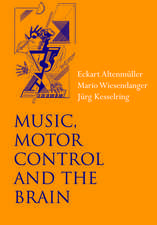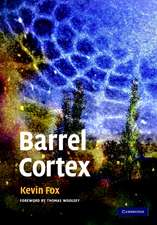The Neuronal Codes of the Cerebellum
Editat de Detlef Hecken Limba Engleză Paperback – 26 oct 2015
Focused on findings related to the neuronal code used by cerebellar neurons for the representation of behavioral and sensory processes, this edited volume will aid scientists in overcoming that knowledge gap, also serving as the first resource to broadly address the different aspects of spike coding in the cerebellum that focuses on spike train analysis.
- Compiles current knowledge about functioning of the cerebellum on a cellular basis and how information is encoded in the cerebellum
- Highlights findings related to the neuronal code used by cerebellar neurons for the representation of behavioral and sensory processes
- Contents include an introduction to the cerebellum and experimental/theoretical techniques, as well as the function of cerebral coding during disorder, learning, behavior generation, motor behavior, and more
- Bridges the gap for cerebellar researchers between single cell biophysics/anatomic studies and behavioral studies
- Incorporates various in vivo approaches with different behavioral paradigms in primates and rodents, modeling studies of coding, and in vitro approaches
Preț: 455.10 lei
Preț vechi: 530.72 lei
-14% Nou
Puncte Express: 683
Preț estimativ în valută:
87.08€ • 90.93$ • 71.91£
87.08€ • 90.93$ • 71.91£
Carte tipărită la comandă
Livrare economică 08-22 aprilie
Preluare comenzi: 021 569.72.76
Specificații
ISBN-13: 9780128013861
ISBN-10: 0128013869
Pagini: 280
Dimensiuni: 152 x 229 x 15 mm
Greutate: 0.46 kg
Editura: ELSEVIER SCIENCE
ISBN-10: 0128013869
Pagini: 280
Dimensiuni: 152 x 229 x 15 mm
Greutate: 0.46 kg
Editura: ELSEVIER SCIENCE
Cuprins
1. Signaling of predictive and feedback information in Purkinje cell simple spike activity
2. DCN rebound firing in vivo: Much ado about almost nothing?
3. Spatio-temporal aspects of cerebellar coding during learning
4. How the vestibulo-cerebellum builds an internal model of self-motion
5. Modeling the generation of cerebellar nuclear spike output
6. Cerebro-cerebellar loops in the rodent brain
7. Cerebellar neuronal codes – perspectives from intracellular analysis in vivo
8. The role of the cerebellum in optimizing saccades
9. Coordination of reaching movements: Cerebellar interactions with motor cortex
10. The role of synchrony and oscillatory neuronal activity in cerebellar control of behavior
11. Single neuron and network computation in realistic models of the cerebellar cortex
2. DCN rebound firing in vivo: Much ado about almost nothing?
3. Spatio-temporal aspects of cerebellar coding during learning
4. How the vestibulo-cerebellum builds an internal model of self-motion
5. Modeling the generation of cerebellar nuclear spike output
6. Cerebro-cerebellar loops in the rodent brain
7. Cerebellar neuronal codes – perspectives from intracellular analysis in vivo
8. The role of the cerebellum in optimizing saccades
9. Coordination of reaching movements: Cerebellar interactions with motor cortex
10. The role of synchrony and oscillatory neuronal activity in cerebellar control of behavior
11. Single neuron and network computation in realistic models of the cerebellar cortex

















